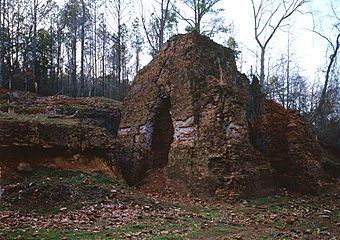Brierfield Furnace facts for kids
Quick facts for kids |
|
|
Brierfield Furnace
|
|

Remnants of the Brierfield Furnace in 1993
|
|
| Nearest city | Brierfield, Alabama |
|---|---|
| Area | 486 acres (197 ha) |
| Built | 1861 |
| Architect | Col. C.C. Huckabee, Jonathan Newton Smith |
| NRHP reference No. | 74000401 |
| Added to NRHP | November 20, 1974 |
The Brierfield Furnace, also known as the Bibb Naval Furnace or Brierfield Ironworks, is a special historical place in Brierfield, Alabama. It covers a large area of about 486 acres (197 hectares) and includes one old building and nine important historical sites. This area was added to the National Register of Historic Places on November 20, 1974. Today, this entire historical area is part of the Brierfield Ironworks Historical State Park, where people can visit and learn about its past.
Contents
History of the Brierfield Ironworks
The Brierfield Furnace site began in 1861. Two planters, Caswell Campbell Huckabee from Greensboro, Alabama and Jonathan Newton Smith from Bibb County, Alabama, bought land near the Little Cahaba River. They started a company called the Bibb County Iron Company. Huckabee provided most of the money and the enslaved workers needed for building.
Building the First Furnace
Richard Fell was hired to build a large stone blast furnace that was 36 feet (11 meters) tall. A blast furnace is a tall oven used to melt iron ore at very high temperatures. In 1862, a rolling mill was also built. A rolling mill uses rollers to flatten and shape metal. The company first made cast iron, which is iron poured into molds. Soon, they switched to making wrought iron, which is stronger and more flexible, and was more profitable. This iron was used to make tools for farms.
The Civil War and Confederate Control
During the American Civil War, the iron made at Brierfield was very good quality. Because of this, Confederate officials made the owners sell the ironworks to the government in 1863 for $600,000. They renamed it the Bibb Naval Furnace.
A new, taller brick furnace, 40 feet (12 meters) high, was built. A railroad line was also built to connect the furnace to the main train line. The iron produced here was then sent to the Confederate arsenal in Selma. An arsenal is a place where weapons are made and stored. By 1864, the furnace was making 25 tons of iron every day. Much of this iron was used to make over 100 Brooke rifles, which were important cannons for the South, at the Selma arsenal.
This important work ended on March 31, 1865. The Bibb Naval Furnace was destroyed by the 10th Missouri Volunteer Cavalry during Wilson's Raid, a large cavalry operation by Union forces.
Rebuilding and Final Closure
After the war, the ironworks was rebuilt by a private company called the Canebrake Company. This new company was started by former Confederates Josiah Gorgas and Francis Strother Lyon. They bought the site from the government for $45,000 in January 1866. They got the ironworks running again by November 2, 1866.
In 1867, Lyon gave the ownership to Gorgas, who became the president of the new Brierfield Ironworks. Gorgas later leased the ironworks to Thomas S. Alvis in 1869. Alvis ran the works until he had to close it because of tough economic times after the Panic of 1873, a major financial crisis.
In 1877, William D. and Kearsley Carter bought and reopened the facilities. By 1882, Thomas Jefferson Peter was managing the operation. Peter had the furnace rebuilt and improved the rolling mill. He also added a nailery (a place to make nails), coke ovens (to make fuel for the furnace), and a washer. However, due to competition from newer, cheaper cut-wire nails from Pittsburgh, the ironworks finally closed for good in December 1894.
After it closed, the site was left empty. During World War II, many bricks were taken from the site to be reused. In 1976, the Bibb County Commission created a park covering 45 acres (18 hectares) because the Bibb County Historical Society wanted to protect the site. This first effort has grown into what is now the Brierfield Ironworks Historical State Park.
The Modern Brierfield Ironworks Historical State Park
Today, the Brierfield Ironworks Historical State Park lets visitors explore the history of the furnace. The park includes the remains of the brick furnace from the 1860s and 1880s, and the old tramway bed from the railroad built in the 1860s. You can also see the brick foundations of the rolling mill from the 1860s and 1880s, and the foundations of the nailery and coke ovens from the 1880s. There is also an old cemetery from the 1850s and the superintendent's house from the 1870s.
Several other historic buildings have been moved to the park from nearby areas to preserve them. These include:
- The Ashby Post Office (around 1900)
- The Brierfield Ironworks Park Office (1894)
- The Wilson Hayes House (around 1900)
- The J. Henry Jones General Store (around 1900)
- The Lightsey Cabin (1840)
- The Sims-Hubbard Log Cabin (around 1850)
- The Billy Mitchell Cabin (1880s)
- The Mulberry Baptist Church (1897)
The park also offers fun activities like an outdoor amphitheater, hiking and nature trails, campsites for camping, and a swimming pool. It's a great place to learn about history and enjoy nature.
See also
 In Spanish: Horno Brierfield para niños
In Spanish: Horno Brierfield para niños



